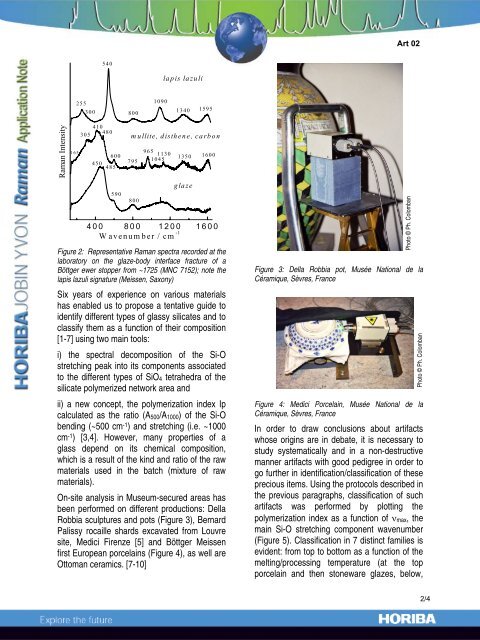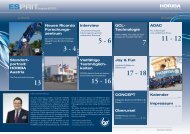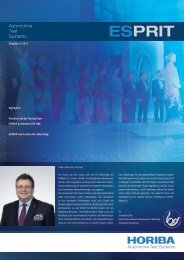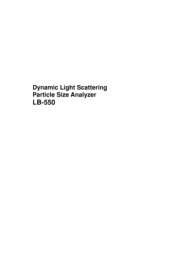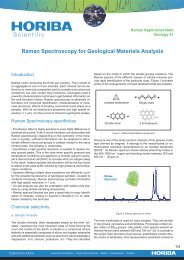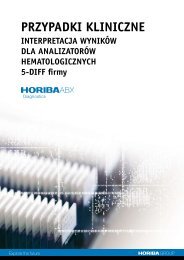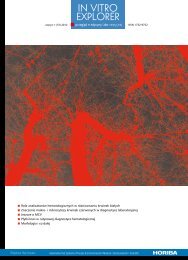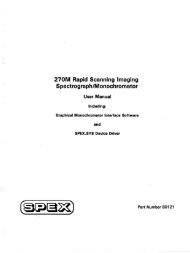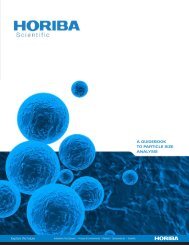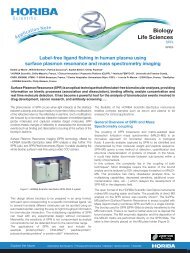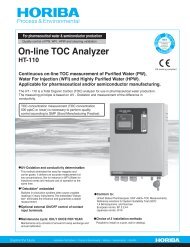Raman Spectroscopy - Art Application Note - Horiba
Raman Spectroscopy - Art Application Note - Horiba
Raman Spectroscopy - Art Application Note - Horiba
You also want an ePaper? Increase the reach of your titles
YUMPU automatically turns print PDFs into web optimized ePapers that Google loves.
<strong>Raman</strong> Intensity<br />
165<br />
255<br />
300<br />
450<br />
540<br />
410<br />
305<br />
480<br />
600<br />
485<br />
590<br />
800<br />
lapis lazuli<br />
mullite, disthene, carbon<br />
795<br />
800<br />
1090<br />
965<br />
1130<br />
1045<br />
1340<br />
1350<br />
glaze<br />
1595<br />
1600<br />
400 800 1200 1600<br />
Wavenumber / cm -1<br />
Figure 2: Representative <strong>Raman</strong> spectra recorded at the<br />
laboratory on the glaze-body interface fracture of a<br />
Böttger ewer stopper from ~1725 (MNC 7152); note the<br />
lapis lazuli signature (Meissen, Saxony)<br />
Six years of experience on various materials<br />
has enabled us to propose a tentative guide to<br />
identify different types of glassy silicates and to<br />
classify them as a function of their composition<br />
[1-7] using two main tools:<br />
i) the spectral decomposition of the Si-O<br />
stretching peak into its components associated<br />
to the different types of SiO4 tetrahedra of the<br />
silicate polymerized network area and<br />
ii) a new concept, the polymerization index Ip<br />
calculated as the ratio (A500/A1000) of the Si-O<br />
bending (~500 cm-1 ) and stretching (i.e. ~1000<br />
cm-1 ) [3,4]. However, many properties of a<br />
glass depend on its chemical composition,<br />
which is a result of the kind and ratio of the raw<br />
materials used in the batch (mixture of raw<br />
materials).<br />
On-site analysis in Museum-secured areas has<br />
been performed on different productions: Della<br />
Robbia sculptures and pots (Figure 3), Bernard<br />
Palissy rocaille shards excavated from Louvre<br />
site, Medici Firenze [5] and Böttger Meissen<br />
first European porcelains (Figure 4), as well are<br />
Ottoman ceramics. [7-10]<br />
<strong>Art</strong> 02<br />
Photo © Ph. Colomban<br />
Figure 3: Della Robbia pot, Musée National de la<br />
Céramique, Sèvres, France<br />
Photo © Ph. Colomban<br />
Figure 4: Medici Porcelain, Musée National de la<br />
Céramique, Sèvres, France<br />
In order to draw conclusions about artifacts<br />
whose origins are in debate, it is necessary to<br />
study systematically and in a non-destructive<br />
manner artifacts with good pedigree in order to<br />
go further in identification/classification of these<br />
precious items. Using the protocols described in<br />
the previous paragraphs, classification of such<br />
artifacts was performed by plotting the<br />
polymerization index as a function of νmax, the<br />
main Si-O stretching component wavenumber<br />
(Figure 5). Classification in 7 distinct families is<br />
evident: from top to bottom as a function of the<br />
melting/processing temperature (at the top<br />
porcelain and then stoneware glazes, below,<br />
2/4


